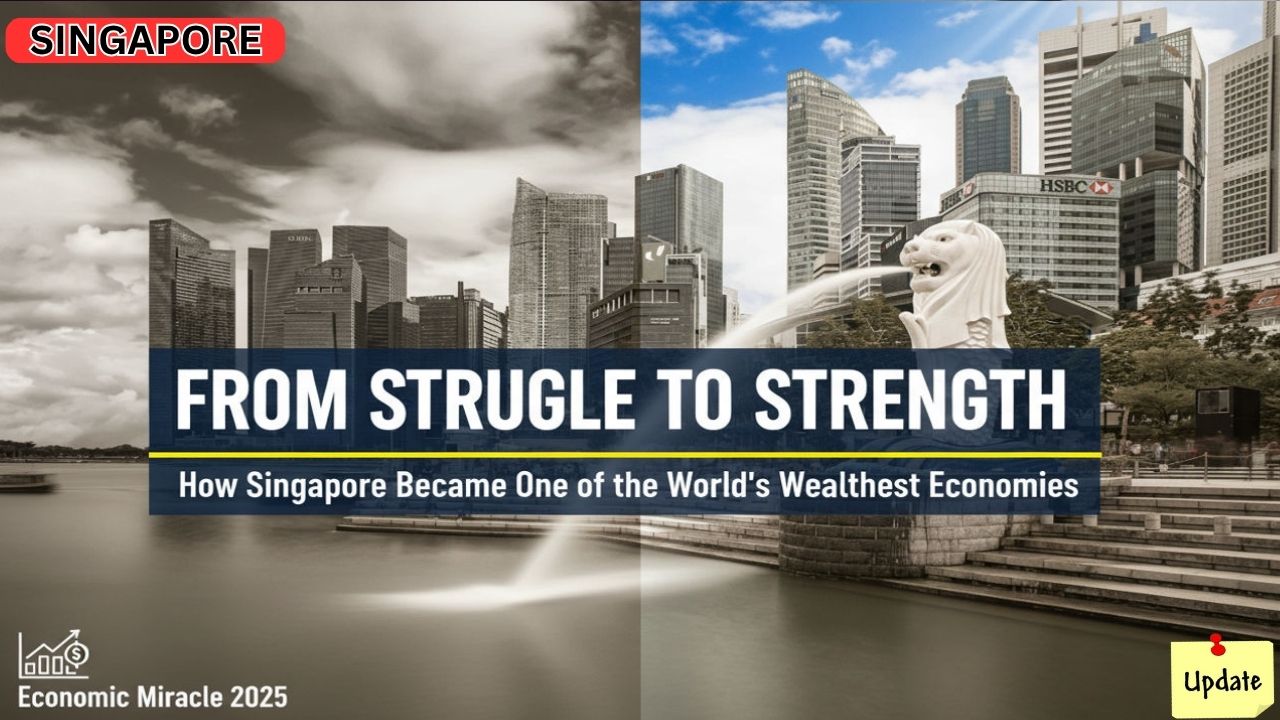Today Singapore is widely recognised as a global hub for finance, trade, and logistics. It is home to a large number of high net worth individuals, one of the busiest ports in the world, a leading financial centre, and a per capita output that rivals or surpasses many larger countries. What often surprises observers is that this compact city-state achieved these outcomes in a remarkably short time. Less than a lifetime ago, Singapore struggled with unemployment, unrest, and inadequate housing. The path from hardship to high income offers practical lessons about nation building, policy design, and the balance between markets and state capacity.
Table of Contents
From Struggle to Strength Short Summary

Item |
Details |
|---|---|
Country |
Singapore |
Core Theme |
Rapid transformation from poverty to prosperity in about 60 years |
Starting Point |
Post-war hardship, civil unrest, unemployment, housing shortages |
Today |
High income economy with strong finance, trade, logistics, and public services |
Why It Worked |
Clean governance, rule of law, trade openness, skills development, housing policy, industrial strategy |
Signature Institutions |
Economic Development Board, Housing and Development Board, Central Provident Fund, Port of Singapore, Monetary Authority of Singapore |
Key Trade-offs |
Cost of living pressures, inequality concerns, reliance on global demand, demographic aging |
Who Should Read |
Policy students, entrepreneurs, investors, urban planners, job seekers |
Official Site |
The Starting Point: A City in Crisis
In the years surrounding independence, Singapore faced an urgent list of challenges. Industrial activity was limited, public health indicators were weak, and the economy lacked natural resources. Different communities lived with deep anxieties over jobs and security. Housing shortages created informal settlements with poor sanitation. Political uncertainty and social tensions made long term planning difficult. When separation from Malaysia arrived, it was not a triumphant moment. It was a test of survival.
The Strategy: Stability First, Growth Next
Singapore leaders set out to build a credible state that could deliver safety, contract enforcement, and clean administration. Political stability, a professional civil service, and strict anti-corruption measures created trust with citizens and investors. The aim was simple and demanding. Provide a platform where domestic and foreign firms could plan and invest with confidence. Courts, regulations, and agencies were strengthened so that rules were clear and fairly applied. This predictable environment became the country first competitive advantage.
Opening to the World
With few natural resources, Singapore leaned into trade. The government backed an export-oriented strategy that welcomed multinational companies while nurturing local enterprise. World class port operations reduced logistics friction. Free trade agreements widened market access. Customs efficiency, modern warehousing, and reliable transport created a tightly run node in global value chains. As manufacturing matured, the economy climbed the value ladder into electronics, pharmaceuticals, finance, and advanced services.
Building Skills and Institutions
Human capital was the next pillar. Education reforms focused on literacy, mathematics, science, and bilingualism. Technical and vocational institutes expanded to align training with industry needs. Continuous learning became a core expectation. The result was a workforce able to adopt new technologies and move into higher productivity roles. Alongside this, the Monetary Authority of Singapore and other agencies developed a reputation for prudence, which anchored financial stability and attracted regional headquarters.
Housing, Savings, and Social Basics
A distinctive feature of Singapore model is its housing policy. The Housing and Development Board planned new towns, built public housing at scale, and integrated amenities, schools, and transport. Over time, home ownership rates rose to among the highest in advanced economies. This was supported by the Central Provident Fund, a mandatory savings system that helps finance housing, healthcare, and retirement. The combination boosted household balance sheets and created stable communities that were connected by efficient public transport and well designed public spaces.
Public Services and Safety
Public safety, clean streets, and reliable infrastructure are not afterthoughts in the Singapore story. They are central to quality of life and to the business environment. Strong policing, rule of law, and well maintained public assets reduced hidden costs that often deter investment. Healthcare capacity improved outcomes through a mix of public provision, co-payments, and targeted subsidies. These basics reinforced social trust and made growth feel tangible.
The Role of the State and the Market
Singapore experience is not a choice between markets or government. It is a disciplined blend of both. Markets set prices, signal demand, and reward efficiency. The state sets the rules, builds public goods, and acts where coordination failures appear. The Economic Development Board exemplifies this approach. It engages industry, identifies new sectors, and removes bottlenecks in land, skills, or regulation. The goal is not to pick winners at random. It is to lower barriers so competitive firms can scale and hire.
Trade-offs and Pressures
Success brings new challenges. Cost of living is a persistent concern for residents. Property values and imported goods prices can strain household budgets. Inequality and wage dispersion require careful policy responses, from skills upgrading to wage support schemes. The population is aging, which raises questions about healthcare capacity, retirement adequacy, and productivity. The economy is also exposed to shifts in global demand, supply chains, and geopolitics. Managing these pressures requires constant adaptation.
What Other Countries and Cities Can Learn
Several practical lessons stand out. First, clean governance and rule of law are not optional. They are the bedrock of investment and social trust. Second, human capital compounds. Systems that reward continuous learning help workers move with technology rather than be displaced by it. Third, urban design matters. Housing, transport, and amenities influence both productivity and social cohesion. Fourth, an open stance to trade and talent can accelerate growth when accompanied by effective integration policies. Finally, institutions that listen to industry while protecting public interest can align incentives and reduce friction.
The Bottom Line
Singapore rise is not a miracle story. It is a case of clear choices, consistent execution, and institutions that learn. From a weak starting point, the country built stability, opened to the world, invested in people, housed its citizens, and delivered reliable public services. The result is a high income, innovative economy with strong global links and high standards of living. The journey is ongoing, and the next phase will require fresh solutions to costs, demographics, and technological change. The foundations, however, remain firm.
Frequently Asked Questions
1) Is Singapore success only due to low taxes or being a financial hub
No. Finance is important, but the model also relies on clean governance, trade openness, skills development, industrial upgrading, and strong public services.
2) How did housing policy influence growth
Mass public housing and town planning stabilised communities, shortened commutes, and supported labour mobility. High ownership rates strengthened household balance sheets.
3) Does Singapore still manufacture goods
Yes. The economy moved into higher value manufacturing such as electronics and pharmaceuticals while expanding finance, logistics, and professional services.
4) What are the main risks ahead
Global demand shocks, supply chain changes, demographic aging, and cost pressures. Policy responses focus on skills, productivity, healthcare capacity, and innovation.
5) Can other countries copy the model
Elements can be adapted, such as anti-corruption, skills alignment, and urban planning. Full replication is difficult since geography, size, and politics differ.
6) How does the government support workers facing change
Through training subsidies, career services, and sectoral transformation plans that encourage firms to adopt technology while upgrading jobs.
7) Why do global firms choose Singapore
Rule of law, predictable regulation, talent, quality infrastructure, and efficient logistics make it a reliable base for regional operations.
For More Information Click HERE











